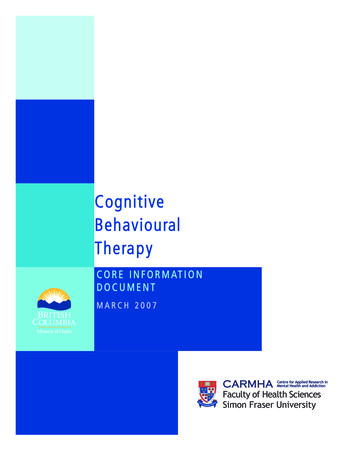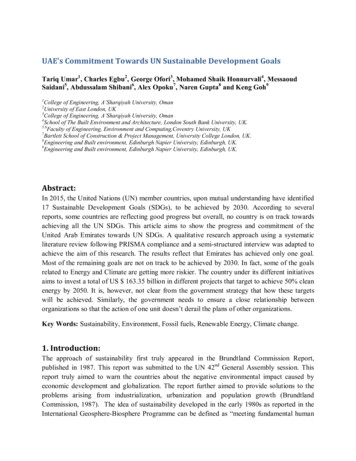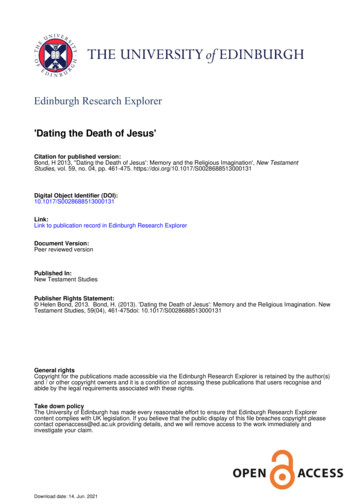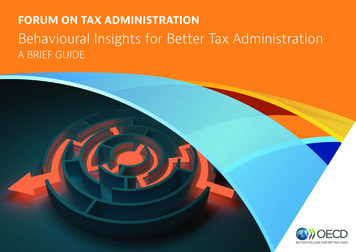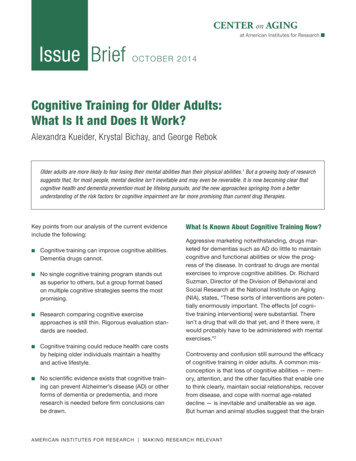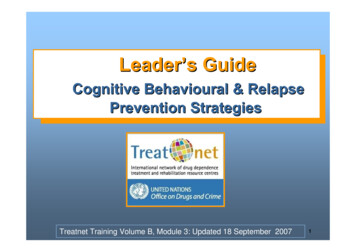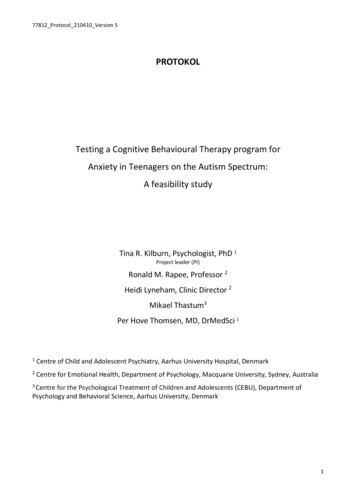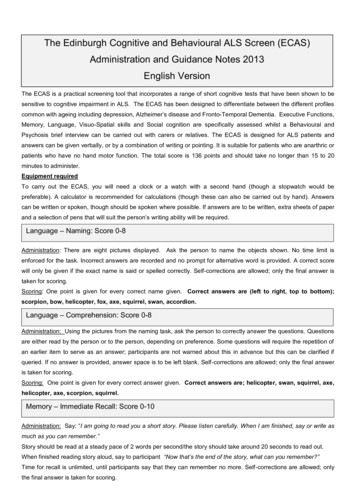
Transcription
The Edinburgh Cognitive and Behavioural ALS Screen (ECAS)Administration and Guidance Notes 2013English VersionThe ECAS is a practical screening tool that incorporates a range of short cognitive tests that have been shown to besensitive to cognitive impairment in ALS. The ECAS has been designed to differentiate between the different profilescommon with ageing including depression, Alzheimer’s disease and Fronto-Temporal Dementia. Executive Functions,Memory, Language, Visuo-Spatial skills and Social cognition are specifically assessed whilst a Behavioural andPsychosis brief interview can be carried out with carers or relatives. The ECAS is designed for ALS patients andanswers can be given verbally, or by a combination of writing or pointing. It is suitable for patients who are anarthric orpatients who have no hand motor function. The total score is 136 points and should take no longer than 15 to 20minutes to administer.Equipment requiredTo carry out the ECAS, you will need a clock or a watch with a second hand (though a stopwatch would bepreferable). A calculator is recommended for calculations (though these can also be carried out by hand). Answerscan be written or spoken, though should be spoken where possible. If answers are to be written, extra sheets of paperand a selection of pens that will suit the person’s writing ability will be required.Language – Naming: Score 0-8Administration: There are eight pictures displayed. Ask the person to name the objects shown. No time limit isenforced for the task. Incorrect answers are recorded and no prompt for alternative word is provided. A correct scorewill only be given if the exact name is said or spelled correctly. Self-corrections are allowed; only the final answer istaken for scoring.Scoring: One point is given for every correct name given. Correct answers are (left to right, top to bottom);scorpion, bow, helicopter, fox, axe, squirrel, swan, accordion.Language – Comprehension: Score 0-8Administration: Using the pictures from the naming task, ask the person to correctly answer the questions. Questionsare either read by the person or to the person, depending on preference. Some questions will require the repetition ofan earlier item to serve as an answer; participants are not warned about this in advance but this can be clarified ifqueried. If no answer is provided, answer space is to be left blank. Self-corrections are allowed; only the final answeris taken for scoring.Scoring: One point is given for every correct answer given. Correct answers are; helicopter, swan, squirrel, axe,helicopter, axe, scorpion, squirrel.Memory – Immediate Recall: Score 0-10Administration: Say: “I am going to read you a short story. Please listen carefully. When I am finished, say or write asmuch as you can remember.”Story should be read at a steady pace of 2 words per second/the story should take around 20 seconds to read out.When finished reading story aloud, say to participant “Now that’s the end of the story, what can you remember?”Time for recall is unlimited, until participants say that they can remember no more. Self-corrections are allowed; onlythe final answer is taken for scoring.
Scoring: Score 1 point for each (either entire or part of) underlined section recalled.For example “annual litter collection” recalled as ‘annual collection’ ‘litter collection’ or ‘annual rubbish collection’ wouldeach score 1 point. Number information must be recalled accurately, for example “Forty two people” recalled as ‘fortysomething’ would score 0 points. This immediate recall score will also be used later on to calculate the percentage ofmemory retained over time. No prompts should be given for specific information, only “is that everything you canremember” should be asked to confirm participant is finished recall.Language – Spelling: Score 0-12Administration: Say “Spell, either by writing or speaking, the following words.”If the person is using assistive technology, ask them to turn off any predictive text facility.Unlimited time is given for spelling of each word. All words are assessed even if early words in the list are incorrect.Move on to the next word if participant is unable or unwilling to attempt spelling of one word.Scoring: Score 1 point for each correct spelling. Self-corrections are allowed; only the final answer is taken forscoring.Caution should be taken in interpretation where low premorbid IQ or a history of reading or spelling difficulties isreported. It is recommended interviewer ask patient and/or carer about premorbid reading and writing abilities.Executive – Fluency Letter S: Score 0-12Administration: The person can perform this task either by speaking or writing. Say: “I am going to give you a letter ofthe alphabet and I would like you to say or write as many words as you can beginning with that letter. But not namesof people or places, or numbers. If writing, say: “You will have two minutes and the letter is S.” If speaking, say “You will have one minute and the letter is S.”Next the person copies/repeats these words. If writing, say: “Copy these words as fast as possible. I will time you. Ready? Begin.” If speaking, say: “Read aloud these words as fast as possible. Before you do this, check that you can readthem. I will time you. Ready? Begin.”Scoring: All answers provided are recorded however the following rules apply for scoring items as correct.Words must be varied for example: sugar, salt, slipper, snow, scream, shoot, scale, scissors .Do not include repetitions, nonsense words or proper names in scoring items correct.Repetitions where a second meaning is provided (e.g. ‘school - the educational institution’ or ‘school - collective nameof fish’) are scored as independent items. Likewise, when items are spoken and a different spelling/meaning isindicated (e.g. slow and sloe) items are scored as independently correct. Where a meaning change is indicated (e.g.savour and savoury) items are scored as independently correct.Plural words will be accepted, only if they have not already been provided in singular form (e.g. slipper, slippers score 1). Perseverations of words such as sit, sat, sitting where meaning is not changed, are not accepted ascorrect (e.g. sit, sat, sitting score 1).In order to account for differences in motor speed and speaking time variations, a Verbal Fluency Index (VFI) iscalculated using the equation below.VFI (test time – time taken to repeat words))Number of correct words generatedFor example, a participant given 60 seconds to complete thetask who generates 5 words and then takes 15 seconds toread these words aloud would have a VFI of 9:60-15 VFI of 95A participant’s VFI is converted to a Fluency score using the conversion table provided in ECAS.
Executive – Reverse Digit Span: Score 0-12Administration: Numbers should be read out at a pace of 1 number per second. Say: “I am going to say somenumbers and I would like you to say them back to me in reverse order. For example, if I say ‘2 3 4’, you should say ‘43 2’. Let’s have a practice. If I say ‘7 1 9’, what would you say?”If participant cannot complete the practice trial, another practice trial is provided at the level of two digits, beforemoving on to test items. If a participant cannot complete a practice trial at the level of two items, the test is scored as 0out of 12 and no further test items are attempted. Advance warning that the number sequences will increase in lengthis provided at the start of each line of a trial. In order to score a trial of a line as correct, participant must accuratelyrecall all items in reverse order. No score is given for individual numbers correctly recalled in an incorrectly recalledsequence. If person gets at least one trial of a line correct, move on to the next line. Self-corrections are allowed; onlythe final answer is taken for scoring. Stop when person gets both trials of a line wrong.Score: Score is total number of trials achieved correctly (out of 12).Executive – Alternation: Score 0-12Administration: Say: “I want you to alternate between numbers and letters, starting with 1-A, then 2-B, 3-C, and so on.Please continue from there, alternating between numbers and letters, in order, without skipping any until I tell you tostop”.Score: One point is given for every correct trial.Executive – Fluency Letter T: Score 0-12Administration: The person can perform this task either by speaking or writing. Say: “I am going to give you a letter ofthe alphabet and I would like you to say or write as many words as you can beginning with that letter. But not namesof people or places, or numbers. This time the word must only be four letters long. No more or less than fourletters.” Note: Plurals are accepted in order to create four letters – for example, Toes. If writing, say: “You will have two minutes and the letter is T.” If speaking, say “You will have one minute and the letter is T.”Next the person copies/repeats these words. If writing, say: “Copy these words as fast as possible. I will time you. Ready? Begin.” If speaking, say: “Read aloud these words as fast as possible. Before you do this, check that you can readthem. I will time you. Ready? Begin.”Scoring: See scoring criteria from previous Fluency task to produce VFI, and conversion table provided in ECAS.Visuospatial – Dot counting: Score 0-4Administration: Say “I would like you to count how many dots are in each box, but without pointing to them”. Progressfrom left to right and top to bottom to move through the squares. All squares should be attempted.Score: One point for each correct box. Correct answers are: Top left 10, top right 8, bottom left 7, bottom right 9.Visuospatial – Cube counting: Score 0-4Administration: Ask the person “How many cubes are in each structure, including the ones you may not be able tosee?” Progress from left to right and top to bottom to move through the cube structures. All structures should beattempted.Score: one point for each correct answer. Correct answers are top left 5, top right 6, bottom left 10 and bottomright 7.
Visuospatial – Number location: Score 0-4Administration: Ask the person “Which number corresponds to the position of the dot?’ Progress from left to right andtop to bottom to move through the squares. All squares should be attempted.Score: One point for each correct answer. Correct answers are top left 6, top right 5, bottom left 2, bottom right 3Executive – Sentence completion: Score 0-12Administration: Say “Listen carefully to these sentences and as soon as I have finished reading them, please tell me,or write, a word that finishes the sentence as quickly as possible.” For example, ‘She was so tired that she wentstraight to bed’. Do not score the first two questions.Now say: “ I’d like you to do that again, but this time the word you give should not make sense whatsoever in thecontext of the sentence. It must not be related to the word that actually completes the sentence. For example, ‘Johncut his hand with the sharp orange’. If person answers with a word which completes the sentence in context thenremind them that the requirement is to provide an answer that bears no significance to the context of the sentence.Progress through all questions, even when incorrect answers are provided. If the person does not respond within 20seconds, move onto the next question.Score: 2 for completely unconnected word, 1 for related word (e.g. associated or opposite meaning) and 0 for exactword. See table below for scoring examples. Note: sentences can be ungrammatical.1Question2 points1 point0 pointsThe postman knocked on the.Car, potato.Window, gate,Doormailbag.23He brought his umbrella withRubber,him in case of.parachute.Sally spread her toast withEarth, sand.Sunshine, wind, ice.RainCereal, egg, oranges.Jam, Marmalade,butter and.4John went to the barber andHoney, CheeseMoon, table.got his hair.5She dived into the swimming.Washed, lengthened,Cutsinged.Garden,Pond, bath, rock.PoolDo, play, buy.Eat, drink.swing.6They all went to the local caféJump,for something to.dance.Social Cognition – Part AAdministration: The first page contains six boxes each with four pictures in each corner.Say: “You are going to see some pictures, one in each corner of a box. You have to choose which picture you likebest. Either point to or say which picture you like best. Please respond as quickly as possible.”Score: Answers are recorded but not scored; responses are used as information to support scoring in the next section.Social Cognition – Part B: Score 0-12Administration: Say: “You are going to see some pictures, one in each corner of a box. You have to choose whichpicture does the face like best. Either point to or say which the face likes best. Please respond as quickly aspossible.’ Progress through all questions even when incorrect answers are provided.
Score: Two points for each correct response. Of the items not correctly identified, score 1 point if answer was NOT theitem that participant picked as their own favourite in the previous section, score 0 points if the item WAS picked astheir own favourite.Memory – Delayed recall: Score 0-10Administration: Say: “At the beginning of this interview, I read you a story. Tell me as much as you can remember fromthat story.” Time for recall is unlimited, until participants say that they can remember no more. Self-corrections areallowed; only the final answer is taken for scoring.Score: 1 point for each (either entire or part of) underlined section recalled. The percentage of memory retained is nowcalculated. Take the total score for Delayed Memory and divide it by the Immediate Memory score, beforemultiplying this number by 100. For example:With a Delayed Memory Score of 8/10, and an Immediate Memory Score of 9/10The percentage of retained memory is 89%.Some patients may recall more at delay than immediate and the percentage will be displayed as being over 100%.Use the conversion table provided in ECAS to derive scoring.Memory – Delayed recognition: Score 0-4Administration: This test should only be done if the person failed to recall one or more items. If all the items wererecalled, skip the test and score 4.Otherwise, say: “Lets see if you can remember anything more about that story. I will ask you some questions, pleasetell me if they are true or false”.Score: Score 1 point for each correct answer; correct answers are marked in bold in this section. If the person gives a“don’t know” answer ask them to make a guess on True or False and score accordingly. Use the conversion tableprovided in ECAS to derive final scoring for recognition section.SCORESLanguageVerbal FluencyExecutiveMemoryVisuospatialNaming, Comprehension, SpellingFluency Letter S, Fluency Letter TReverse Digit Span, Alternation, Sentence Completion, SocialCognitionALS-SPECIFIC:/48/100Immediate recall, Delayed retention, Delayed recognitionDot Counting, Cube Counting, Number Location/24/12ALS NON-SPECIFIC:/36ECAS TOTAL SCORE/136UK CUT OFF SCORES FOR ABNORMALITY:/28/241ECAS TOTAL SCORE105ALS-SPECIFIC77ALS NON-SPECIFIC24Language26Verbal Fluency14Executive33Memory13Visuospatial10
Study specific informationInclusion CriteriaPeople with a clinically confirmed diagnosis of ALS as per the El Escorial criteria should be included into the Study.Exclusion CriteriaPeople in the terminal stages of ALS and those who do not fulfil the El Escorial criteria for diagnosis of ALS should beexcluded from the study. Also excluded are patients with severe diabetes, epilepsy, pre-existing psychiatric disorder,or alcohol/substance-related disorders, severe head injury that has required hospitalisation in an intensive-caresetting, traumatic brain injury including subarachnoid haemorrhage, and any other significant illness such ascerebrovascular disease or stroke. See also Clinical Data section.Clinical and Background DataInformation on the following variables may of use: Age, Gender, Handedness, years of education/highest level ofeducation, regions affected at onset of disease, regions affected at testing, family history ofALS/dementia/parkinsonson’s disease, respiration (SNIPP/FVC/Noninvasive ventilation), ALS-FRS, RIG/PEG.Respiratory function should be taken by a nurse or obtained from patient’s medical notes. If possible data should betaken at time of ECAS (rather than retrospective data), as there can be impairment with an increase in respiratorydysfunction. If current data is not available or cannot be immediately obtained, clinical data obtained within the pastmonth can be informative.ALS Carer Behaviour ScreenGuidance and AdministrationEnglish VersionGuidance.Please ask the carer or relative to complete this screen in private from the patient, ideally in a separate room. Thereare five components to this screen.Some people may have noticed a change in all areas, some in a few and others may note there are no changes withthe patient. Please ask the carer or relative to give any examples if possible.Administration – Score 0-10Please ask the carer about the listed possible behaviours. Symptoms should have occurred repeatedly and not juston one instance, and may have occurred prior to the development of any motor signs. Tick ‘Yes’, ‘No’ or ‘Don’t Know’.If ‘Yes’, please provide a brief written description. Give one mark for every ‘Yes’ response (maximum 10).ALS – Psychosis ScreenGuidance and AdministrationEnglish VersionGuidancePlease ask the carer or relative to complete this section away from the patient, ideally in another room. Please remindthe carer or relative that the questions asked are only relevant since the onset of ALS.Administration- score 0-3Please ask the carer about the following possible symptoms. Tick ‘Yes’, ‘No’ or ‘Don’t Know’. If ‘Yes’, please provide abrief written description. Give one mark for every ‘Yes’ response (maximum 3).GuidancePlease ask the carer or relative the listed questions. If the answer is Yes to any question please note any relevantexamples or comments.
Guidelines for TranslationWe provide below guidelines for translation however after reading and considering these points, you may wish tocontact Drs Thomas Bak and Dr Sharon Abrahams to coordinate all language and culturally specific issues,thomas.bak@ed.ac.uk s.abrahams@ed.ac.ukGood practice would require a naïve researcher who is fluent in both the language of translation and in English toback-translate the new version into English, in order to see that any translation accurately matches the original Englishversion.Language - NamingIf items are not easy to translate into local language and culture choice of items for selection can be made via thefollowing criteria: half the items should be living, and half non-living. Within the non-living category, manipulable andnon-manipulable objects should be included. One option would be to include one tool, one musical instrument, oneitem of clothing and one vehicle (as is the case in ECAS English version). Frequency of items selected should be lowenough that items are not easy to name, yet not so high that they cannot be named by all controls.Note: monochrome drawings are recommended to facilitate photocopying.Language - ComprehensionItems should include questions where understanding depends on a verb (for example, “something used for chopping”,“something that you can fly in”). Ideally comprehension should include different grammatical constructions (forexample, “something with a sharp edge”).Note: it is better to avoid having one question pertaining to each naming item because patients can then predict lateranswers by a process of elimination rather than comprehension.Memory – Immediate recallStory should be adapted to local culture where necessary.Language - SpellingItems should include, in comparable numbers, nouns, verbs and compound words. Compound words should consistof noun-verb combinations.Items should be of a low-to-medium frequency such that most controls should be able to spell items yet not so highthat all controls can spell all items.In alphabetic languages words should be mid-length, polysyllabic words.In morphologically complex languages we would encourage use of different grammatical forms of words (past tense,continuous, inflected nouns etc.)Verbal Fluency - LetterLetters to use are at the discretion of the researcher however, the prevalence of words beginning with the letter shouldhave a similar frequency in language of conversion to that of words beginning with letter S in English.In our experience written and spoken verbal fluency performance is comparable after VFI calculation. Data is,however, still being collected and this opinion may be revised in light of data collected in 2013.Each translated ECAS should collect relevant control data and corresponding conversion tables should beconstructed. The technique for producing conversion tables is provided below and should be derived from the data ofat least 40 healthy controls, with 20 of these healthy controls providing spoken responses and the other 20 healthycontrols providing written responses.
Converted scorePerformance bracket0 X 6.75 SD2X 5.25 SD to X 6.74 SD4X 3.75 SD to X 5.24 SD6X 2.25 SD to X 3.74 SD8X 0.75 SD to X 2.24 SD10X – 0.75 SD to X 0.74 SD12 X – 0.76 SDWhere X healthy control mean, and SD healthy control standard deviationVerbal Fluency – Letter and restricted number of letterLetters to use are at the discretion of the local researcher who will have knowledge on typical letters used in fluencytheir local language. However, the prevalence of words beginning with the given letter and consisting of the specifiedamount of letters should have a similar frequency in language of conversion to that of words beginning with letter Tand consisting of four letters in English.In our experience written and spoken verbal fluency performance is comparable after VFI calculation. Data is,however, still being collected and this opinion may be revised in light of data collected in 2013.Each translated ECAS should collect relevant control data and corresponding conversion tables should beconstructed. The technique for producing conversion tables is provided below and should be derived from the data ofat least 40 healthy controls, with 20 of these healthy controls providing spoken responses and the other 20 healthycontrols providing written responses.Performance bracket X 6.75 SDX 5.25 SD to X 6.74 SDX 3.75 SD to X 5.24 SDX 2.25 SD to X 3.74 SDX 0.75 SD to X 2.24 SDX – 0.75 SD to X 0.74 SD X – 0.76 SDConverted score024681012Where X healthy control mean, and SD healthy control standard deviationExecutive – Sentence completionTranslation of this task requires a language specialist and researchers should contact Dr Thomas Bak, as above.1. Abrahams, S., Newton, J., Niven, E.H., Foley, J. & Bak, T.H.B. Screening for cognitive and behaviouralchanges in ALS (2013). Amyotrophic Lateral Sclerosis and Frontotemporal Degenerations. Posted onlineJune 13, 2013. doi:10.3109/21678421.2013.805784Acknowledgement: The development f the ECAS was funded by an award from the Motor Neurone DiseaseAssociation, UK.
The ECAS is a practical screening tool that incorporates a range of short cognitive tests that have been shown to be sensitive to cognitive impairment in ALS. The ECAS has been designed to differentiate between the different profiles common with ageing including depression, Alzheimer's disease and Fronto-Temporal Dementia. Executive Functions,


